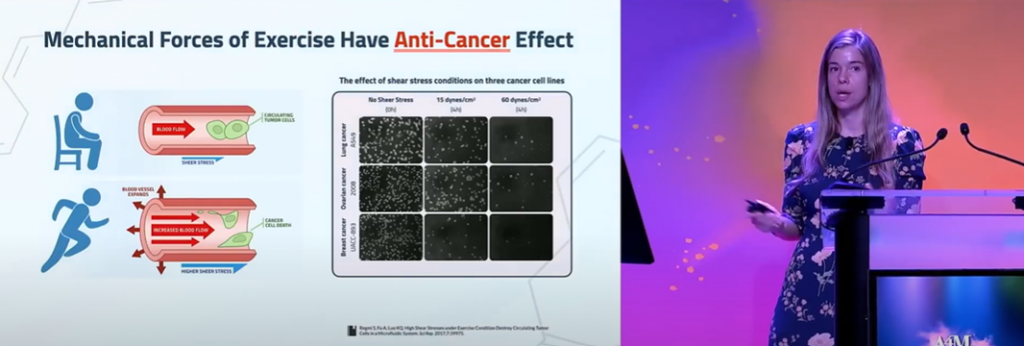Key Points:
- Dr. Patrick says that cardiorespiratory fitness — measured by the maximal amount of oxygen our bodies utilize during exercise — is perhaps our best measure of longevity.
- She says that through vigorous exercise — pushing yourself to 80% of your maximum heart rate — for four minutes with three minutes of recovery can significantly improve cardiorespiratory fitness.
- Dr. Patrick explains how this exercise routine may also improve cognition and work against cancer.
Dr. Rhonda Patrick, a celebrity biochemist and aging expert, says that if we could reap the benefits of exercise in the form of a pill, it would be the best longevity supplement available. In a presentation she gave at the Longevity Fest 2023, Dr. Patrick says that we can harness a vigorous exercise routine to improve our cardiorespiratory fitness. She adds that we can measure cardiorespiratory fitness by assessing the maximum amount of oxygen our cells utilize when exercising, also known as the VO2 max. Dr. Patrick also says that cardiorespiratory fitness is perhaps one of the best biomarkers we have of longevity.
Moreover, she explains how vigorous exercise may enhance cognition and work against cancer. Thus, adhering to a vigorous exercise routine may help improve an important indicator of longevity — cardiorespiratory fitness — and enhance cognition and work against cancer as we get older.
The best way she recommends to improve cardiorespiratory fitness with vigorous exercise is to engage in any exercise that propels your heart rate to about 75% to 80% of its maximum. Pushing yourself to this degree for about four minutes and then resting for three minutes about four times per session — a routine called high-intensity interval training — yields the best results, according to Dr. Patrick. She also recommends engaging in high-intensity interval training three to four times per week.
The Longevity Benefits Associated with Improving Cardiorespiratory Fitness
Improving cardiorespiratory fitness with vigorous exercise may help extend your lifespan. Accordingly, one study suggests that high-intensity interval training can modestly increase your VO2 max. What’s more, a study has correlated each increased unit of VO2 max (1 mL/kg/minute) with a 45-day extension in life expectancy.
“If you could pill up what you could do with vigorous exercise, then I think that is like right now the best longevity drug we have for delaying the aging process and improving healthspan and improving lifespan,” says Dr. Patrick.
Vigorous Exercise May Enhance Cognition
Dr. Patrick goes on to describe vigorous exercise’s benefits on cognition. As such, she says that vigorous exercise pushes muscles to the extent that the oxygen going to muscles during vigorous exercise does not match the muscle’s metabolic needs. With vigorous exercise, when muscles cannot get enough oxygen, cells shift from using cell power generators — mitochondria — and oxygen for energy to breaking down glucose in a cellular process called glycolysis. Glycolysis does not require oxygen, and muscles also secrete a byproduct molecule called lactate during glycolysis.
Dr. Patrick says that we used to think lactate was just an insignificant byproduct of glycolysis, but we are beginning to find that it has substantial benefits. Along those lines, lactate secretion from muscles serves as a signaling molecule that the brain, heart, and liver consume as a reliable form of energy. Furthermore, elevated circulating lactate has been correlated with increased levels of a protein called brain-derived neurotrophic factor (BDNF) in the brain.
BDNF is important for the generation of new neurons in a brain region with crucial roles in memory formation and retrieval called the hippocampus. Dr. Patrick also says that increased BDNF is associated with improved learning, memory, and mood.
Additionally, according to Dr. Patrick, increased lactate in the brain from vigorous exercise has been linked to increased levels of a neuronal signaling molecule and hormone called norepinephrine. Norepinephrine is important for focus and attention. Circulating lactate after vigorous exercise may further enhance cognition by enhancing focus through the release of norepinephrine.
Dr. Patrick Explains Evidence Behind Vigorous Exercise’s Anti-Cancer Benefits
What’s more, Dr. Patrick explains vigorous exercise’s possible anti-cancer benefits. Along those lines, she says that the mechanical force from circulating blood during vigorous exercise works against cancer. In that regard, circulating tumor cells — which are cells that detach from a tumor and enter blood circulation — undergo cell death from the shearing forces of blood flow. Additionally, she says that the more intense the exercise and the greater the blood flow, the higher the proportion of circulating tumor cells that die. In that sense, vigorous exercise may serve as a way to kill a swath of circulating tumor cells.
In line with this idea, she says exercising for six months for 150 minutes per week significantly reduced circulating tumor cells in patients with colon cancer. Furthermore, colon cancer patients who engaged in an exercise routine had a 40% reduction in cancer recurrence and a 63% reduction in mortality. Thus, engaging in vigorous exercise may work against cancer and prevent its recurrence.
Engaging In Vigorous Exercise May Extend Your Life
Engaging in vigorous exercise as opposed to moderate exercise is a key aspect of Dr. Patrick’s tips. For example, up to 40% of people do not show cardiorespiratory improvements after going through moderate-intensity exercise for ~2.5 hours per week for several months. For this reason, Dr. Patrick recommends engaging in a vigorous exercise routine to ensure longevity-related physical enhancements.
You can engage in vigorous exercise by pushing your heart rate to about 80% of its maximum rate for four minutes with three minutes of rest four times a day — a type of high-intensity interval training. Doing so about three to four times a week regularly may improve your cardiorespiratory fitness, an important indicator of longevity, enhance your cognition, and work against cancer. In this way, you can reap the benefits of what Dr. Patrick refers to as the most powerful longevity intervention available — vigorous exercise.


